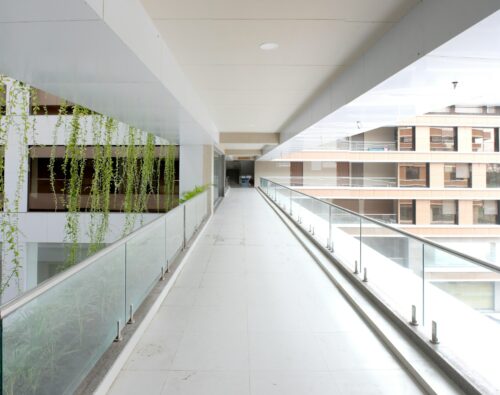Solving Entry Problems with Commercial Ramps for Small Businesses

Small businesses face many challenges, and one of the often-overlooked issues is accessibility. When steps, uneven pavements, and narrow entrances become barriers, it limits who can access a storefront. Accessibility is important not just for compliance or legal reasons; it’s about welcoming everyone, including those with mobility challenges. Ensuring that your entrance is easily accessible can significantly enhance customer experience, making your business more inviting.
Every customer who walks through your door is a step closer to potential success, and by addressing entry issues, you open up your business to a wider audience. Imagine a busy shopping day when a customer with a stroller or a delivery person with a heavy cart struggles to get past a few steps. This not only affects customer satisfaction but can also impact your bottom line. Making your business accessible by solving entry problems can be a simple yet effective way to encourage traffic and growth.
Understanding Entry Challenges for Small Businesses
Many small businesses in Ottawa experience common entry challenges that might not be on the radar for everyone. Have you ever noticed how just a single step can become a barrier? Here are typical obstacles many small business owners face:
– Uneven Surfaces: These can trip people up, literally. Whether it’s a cracked sidewalk or a lopsided pathway, uneven surfaces aren’t good for anyone.
– Single Steps or High Thresholds: One or two steps might not seem significant but can make a world of difference for someone in a wheelchair or a parent with a double stroller.
– Narrow Entrances: Tight spots can limit accessibility and even deter some customers from entering.
These challenges don’t just impact those with mobility issues; they also affect parents with young children, elderly customers, and delivery workers. In practical terms, addressing these entry obstacles is about more than being inclusive; it’s about ensuring smooth business operations. By making your entrance user-friendly, you can create a positive impression and build a loyal customer base. Adjusting for these common challenges can make a significant difference in customer flow and satisfaction.
Types of Commercial Ramps Available
When it comes to making a business accessible, choosing the right kind of ramp is key. There are several options to consider based on the specific needs of your location and clientele. Here are a few types to think about:
– Modular Ramps: These are a versatile choice because they can be adjusted to different lengths and configurations. Ideal for businesses expecting to cater to varying accessibility needs over time, these ramps are durable and can be customized to fit a variety of spaces.
– Portable Ramps: This is perfect for businesses where a more flexible solution is needed. You can easily move them where you need them most. They’re great if you have multiple entrance points or often rearrange your space.
– Threshold Ramps: Small but mighty, these ramps help bridge those pesky little heights that cause big problems. Perfect for single steps or slightly raised doorways, threshold ramps ensure smooth access without the need for large-scale installations.
Each option has its own set of benefits, and understanding the particular needs of your entrance can guide you to make the best choice. It’s about finding that sweet spot between functionality and cost-effectiveness.
Benefits of Installing Commercial Ramps
Introducing commercial ramps to your business can bring about immense benefits, both qualitatively and quantitatively. It’s not just about meeting certain standards; it’s about opening doors to everyone.
Firstly, ramps naturally invite more foot traffic. As word gets around that your business is accessible to people with mobility aids, like wheelchairs or walkers, you’re likely to see an increase in visitors. Accessibility can be a deciding factor in choosing where to shop or dine.
Safety is another factor. Ramps reduce the likelihood of accidents. When designed properly, they offer a secure path, easing the experience for those who might struggle with traditional staircases. Ensuring safety for customers reflects well on your business, showing that you care about everyone’s experience.
And let’s not forget about regulations. Legal requirements often push businesses to adapt their spaces for accessibility. Installing ramps keeps your business in compliance, helping avoid potential fines and liabilities. While regulations may vary, making these improvements means you’re always on the right side of accessibility standards.
Choosing the Right Commercial Ramp for Your Business
Finding the best ramp for your space might feel like a challenge, but focusing on some key aspects helps simplify the decision-making process. Start by identifying the space you have available. It impacts which ramp type will fit and function well at your entrance.
Next, think about who will use it. Different users may need unique solutions, so consider what your typical customer experience might be. This can guide the choice between more temporary, portable options and permanent structures like modular ramps.
Material matters, too. Some ramps are made of metal, others of wood or rubber. Each comes with its own set of maintenance needs and durability considerations. Picking the right one depends on Ottawa’s weather conditions and how frequently the ramp will be in use.
Lastly, while a DIY approach might seem tempting to save some bucks, getting professional help ensures everything is up to code and safe for everyone. A professionally installed ramp not only complies with legal requirements but also ensures a seamless experience for users. Proper installation guarantees longevity and effectiveness, keeping your customers happy and your entrance reliable.
Get Ready for a More Accessible Business Entry
Taking these steps towards making a commercial space accessible isn’t just a task; it’s a forward-thinking strategy with full integration, welcoming everyone through your doors. Not only does this drive customer loyalty, but it also stands as a testament to inclusivity and adaptability.
Integrating ramps into your entryway is about more than meeting regulatory requirements. It makes everyone feel appreciated and considered. People notice when businesses take the time to care for every visitor.
By addressing entry challenges actively, businesses demonstrate a commitment to accessibility and customer comfort. This kind of change doesn’t just happen overnight. It’s a process, but with the right approach, small businesses can easily overcome entry obstacles and open their doors to a broader audience. Making this move not only aligns with legal standards but also benefits the community, creating a ripple effect of inclusion and approachability.
Elevate your small business by ensuring it’s accessible to every customer. Regional Ramp offers a wide array of solutions like accessible ramps that can make your storefront welcoming and inclusive. Our team is here to help you create an entryway that not only meets regulatory requirements but also invites customers to experience your business effortlessly. Contact us today to make your business more accessible and attractive to a diverse clientele.

